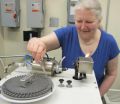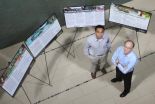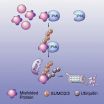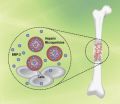(Press-News.org) New research by an international consortium, including a researcher from Lawrence Livermore National Laboratory, may help physicians better understand the chronological development of a brain aneurysm.
Using radiocarbon dating to date samples of ruptured and unruptured cerebral aneurysm (CA) tissue, the team, led by neurosurgeon Nima Etminan, found that the main structural constituent and protein – collagen type I – in cerebral aneurysms is distinctly younger than once thought.
The new research helps identify patients more likely to suffer from an aneurysm and embark on a path toward prevention.
Simplified, a CA is a blood-filled bulge formed in response to a weakness in the wall at branching brain arteries. If the bulge bursts, the person can undergo a brain hemorrhage, which is a subtype of stroke and a life-threatening condition.
For decades, doctors have assumed that CAs rarely undergo structural change, and earlier theories speculated that CAs grow at a constant rate. The new findings, which appear in the June issue of the journal Stroke, challenge the concept that CAs are present for decades and that they undergo only sporadic episodes of structural change. In view of the these findings, it seems more likely that they alternate between periods of stability and instability during which they are prone to rupture.
For patients with CAs, who are more likely to undergo an aneurysm rupture due to risk factors such as smoking or hypertension, the international team including LLNL's Bruce Buchholz found that the age of collagen type I was significantly younger than those samples taken from people with no risk factors.
The ample amount of relatively young collagen type I in CAs suggests that collagen is changing all the time in aneurysms, which is significantly more rapid in patients with risk factors, Buchholz said.
Radiocarbon bomb-pulse dating uses an isotopic signature created by above-ground nuclear testing between 1955 and 1963, which nearly doubled the amount of carbon-14 in the atmosphere.
When the above-ground test-ban treaty took effect in 1963, atmospheric levels of radiocarbon began to decline as carbon-14 migrated into the oceans and biosphere. Living organisms naturally incorporate carbon into their tissues as the element moves through the food chain. As a result, the concentration of carbon-14 leaves a permanent time stamp on every biological molecule.
"This research may help doctors to formulate better screening and identification of those people at increased risk of an aneurysm rupture," Buchholz said.
The prevalence of unruptured CAs in the general population is 2 percent to 3 percent. The rate of death when they rupture is more than 35 percent. The high rate of death has led the medical community to try to understand the formation and natural history of these lesions to define standards for screening, treatment and identification of those CAs that are likely to rupture.
INFORMATION:
Other institutions include: Department of Neurosurgery and Institute of Forensic Medicine Heinrich-Heine Universität; Institute for Physiological Chemistry and Pathobiochemistry, Westfalian Wilhelms-University; Department of Neurology, Mayo Clinic; Department of Epidemiology, University of Iowa; Division of Neurosurgery, St. Michael's Hospital; Keenan Research Centre for Biomedical Science and the Li Ka Shing Knowledge Institute of St. Michael's Hospital; and the Department of Surgery,University of Toronto.
Founded in 1952, Lawrence Livermore National Laboratory provides solutions to our nation's most important national security challenges through innovative science, engineering and technology. Lawrence Livermore National Laboratory is managed by Lawrence Livermore National Security, LLC for the U.S. Department of Energy's National Nuclear Security Administration.
A tool to better screen and treat aneurysm patients
2014-05-29
ELSE PRESS RELEASES FROM THIS DATE:
Gender stereotypes keep women in the out-group
2014-05-29
New Rochelle, NY, May 29, 2014—Women have accounted for half the students in U.S. medical schools for nearly two decades, but as professors, deans, and department chairs in medical schools their numbers still lag far behind those of men. Why long-held gender stereotypes are keeping women from achieving career advancement in academic medicine and what can be done to change the institutional culture are explored in an article in Journal of Women's Health, a peer-reviewed publication from Mary Ann Liebert, Inc., publishers. The article is available free on the Journal of Women's ...
Caught by a hair
2014-05-29
Crime fighters could have a new tool at their disposal following promising research by Queen's professor Diane Beauchemin.
Dr. Beauchemin (Chemistry) and student Lily Huang (MSc'15) have developed a cutting-edge technique to identify human hair. Their test is quicker than DNA analysis techniques currently used by law enforcement. Early sample testing at Queen's produced a 100 per cent success rate.
"My first paper and foray into forensic chemistry was developing a method of identifying paint that could help solve hit and run cases," explains Dr. Beauchemin. "Last year, ...
Neural transplant reduces absence epilepsy seizures in mice
2014-05-29
New research from North Carolina State University pinpoints the areas of the cerebral cortex that are affected in mice with absence epilepsy and shows that transplanting embryonic neural cells into these areas can alleviate symptoms of the disease by reducing seizure activity. The work may help identify the areas of the human brain affected in absence epilepsy and lead to new therapies for sufferers.
Absence epilepsy primarily affects children. These seizures differ from "clonic-tonic" seizures in that they don't cause muscle spasms; rather, patients "zone out" or stare ...
Drop in global malnutrition depends on ag productivity, climate change
2014-05-29
WEST LAFAYETTE, Ind. - Global malnutrition could fall 84 percent by the year 2050 as incomes in developing countries grow - but only if agricultural productivity continues to improve and climate change does not severely damage agriculture, Purdue University researchers say.
"The prevalence and severity of global malnutrition could drop significantly by 2050, particularly in the poorest regions of the world," said Thomas Hertel, Distinguished Professor of Agricultural Economics. "But if productivity does not grow, global malnutrition will worsen even if incomes increase. ...
Penn study shows how misfolded proteins are selected for disposal
2014-05-29
PHILADELPHIA – It's almost axiomatic that misfolded proteins compromise how cells normally function and cause debilitating human disease, but how these proteins are detected and degraded within the body is not well understood. Neurodegenerative diseases – including Alzheimer's disease, Parkinson's disease, amyotrophic lateral sclerosis (Lou Gehrig's disease), Huntington's disease, and spinocerebellar ataxias – exact a devastating toll on aging populations throughout the world.
"Yet, there is virtually no cure for any of these diseases, and clinical trials have yielded ...
Tropical Storm Amanda gets bisected and animated by NASA's CloudSat
2014-05-29
VIDEO:
This animation shows how Cloudsat was able to get the image shown.
Click here for more information.
Tropical Storm Amanda continues to weaken in the eastern Pacific from dry air and wind shear. NASA's CloudSat satellite captured a view of the storm from the side revealing heavy precipitation when the storm was the most powerful May Eastern Pacific on record.
NASA's CloudSat satellite flew over Hurricane Amanda in the east Pacific on May 25, 2014 at 2100 UTC (5 p.m. EDT) ...
An ecological risk research agenda for synthetic biology
2014-05-29
Washington — Environmental scientists and synthetic biologists have for the first time developed a set of key research areas to study the potential ecological impacts of synthetic biology, a field that could push beyond incremental changes to create organisms that transcend common evolutionary pathways.
The Synthetic Biology Project at the Wilson Center and the Program on Emerging Technologies at the Massachusetts Institute of Technology convened the interdisciplinary group of scientists and are releasing the report, Creating a Research Agenda for the Ecological Implications ...
Engineering a better way to rebuild bone inside the body
2014-05-29
Traumatic bone injuries such as blast wounds are often so severe that the body can't effectively repair the damage on its own. To aid the recovery, clinicians inject patients with proteins called growth factors. The treatment is costly, requiring large amounts of expensive growth factors. The growth factors also disperse, creating unwanted bone formation in the area around the injury.
A new technology under development at the Georgia Institute of Technology could one day provide more efficient delivery of the bone regenerating growth factors with greater accuracy and ...
Improved identification of war wound infections promises more successful treatment
2014-05-29
War wounds that heal successfully frequently contain different microbial species from those that heal poorly, according to a paper published ahead of print in the Journal of Clinical Microbiology. These and other findings have important implications for improving wound healing, says first author Nicholas Be of Lawrence Livermore National Laboratory, Livermore, California.
The problem the researchers were addressing is that culture-based identification, which has been used to assay war wound infections, misses the many species that are difficult or impossible to culture. ...
Huge tooth fossil shows marine predator had plenty to chew on
2014-05-29
A fossilised tooth belonging to a fearsome marine predator has been recorded as the largest of its kind found in the UK, following its recent discovery.
A team of palaeontologists have verified the tooth, which was found near Chesil Beach in Dorset, as belonging to a prehistoric relative of modern crocodiles known as Dakosaurus maximus.
The tooth, which has a broken tip, is approximately 5.5 cm long.
Researchers and curators from University of Edinburgh and the Natural History Museum in London identified the item after it was bought at an online auction by a fossil ...






